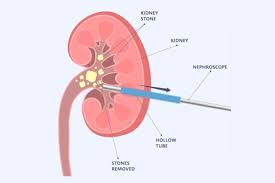Percutaneous nephrolithotomy (PCNL) is a minimally invasive surgical procedure used to remove kidney stones that are too large to pass on their own, cannot be broken down with extracorporeal shock wave lithotripsy (ESWL), or are causing severe symptoms. It is typically indicated for stones larger than 2 cm in diameter, staghorn calculi (branched stones that occupy a large part of the kidney), or in cases where other less invasive treatments have failed.
Procedure of PCNL:
Preoperative Preparation:
The patient is given general anesthesia to ensure they are unconscious and pain-free during the procedure.
Antibiotics may be administered to prevent infection.
Imaging studies, such as CT scans, are often performed preoperatively to determine the exact size, location, and number of stones.
Access to the Kidney:
The patient is usually positioned on their stomach (prone position) to allow easier access to the kidney.
A small incision, typically about 1 cm, is made in the skin on the back overlying the kidney.
Using fluoroscopic (X-ray) or ultrasound guidance, a needle is inserted through the skin and into the kidney to create a tract to the stone.
Dilation of the Tract:
The tract is then gradually dilated (widened) using a series of dilators or a balloon dilator to allow the passage of surgical instruments.
A sheath is placed into the tract to maintain the opening and allow the insertion of instruments.
Stone Removal:
A nephroscope (a type of endoscope) is inserted through the sheath into the kidney.
The nephroscope allows the surgeon to visualize the stone directly.
Stones can be broken up using various tools, such as laser fibers, ultrasonic probes, or pneumatic lithotripters, and the fragments are then removed through the sheath.
Larger fragments may be grasped and extracted directly.
Completion and Drainage:
Once all the stone fragments are removed, the surgeon inspects the kidney to ensure it is clear of stones.
A nephrostomy tube (a tube that drains urine from the kidney to the outside of the body) may be placed to ensure proper drainage and to prevent urine leakage from the tract site.
Sometimes, a ureteral stent (a tube placed inside the ureter) is also inserted to facilitate urine flow from the kidney to the bladder.
Postoperative Care:
The patient is monitored in the recovery area and may need to stay in the hospital for 1-2 days.
Pain management, fluid intake, and activity levels are carefully managed.
Follow-up imaging may be performed to ensure all stones have been removed.
The nephrostomy tube is usually removed after a few days, once the surgeon confirms that the kidney is draining properly and there is no significant bleeding or infection.
Benefits and Risks:
Benefits:
PCNL is highly effective for large kidney stones.
It minimizes damage to the kidney and surrounding tissues compared to open surgery.
Shorter recovery time compared to traditional open surgery.
Risks:
Bleeding, which may require a blood transfusion.
Infection, which can sometimes be severe.
Injury to the kidney or surrounding organs.
Urine leakage from the kidney.
Need for additional procedures if stones are not completely removed.
PCNL is considered a safe and effective procedure when performed by experienced surgeons, offering significant relief from the symptoms and complications associated with large kidney stones.





Comments